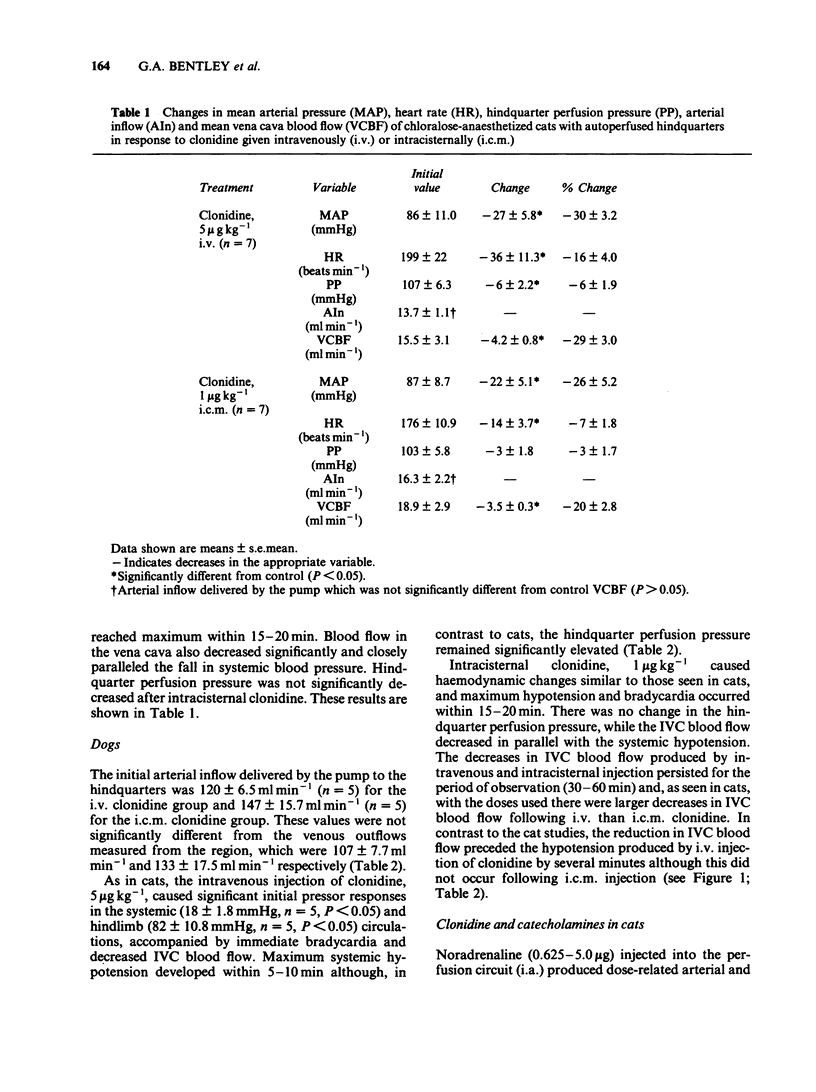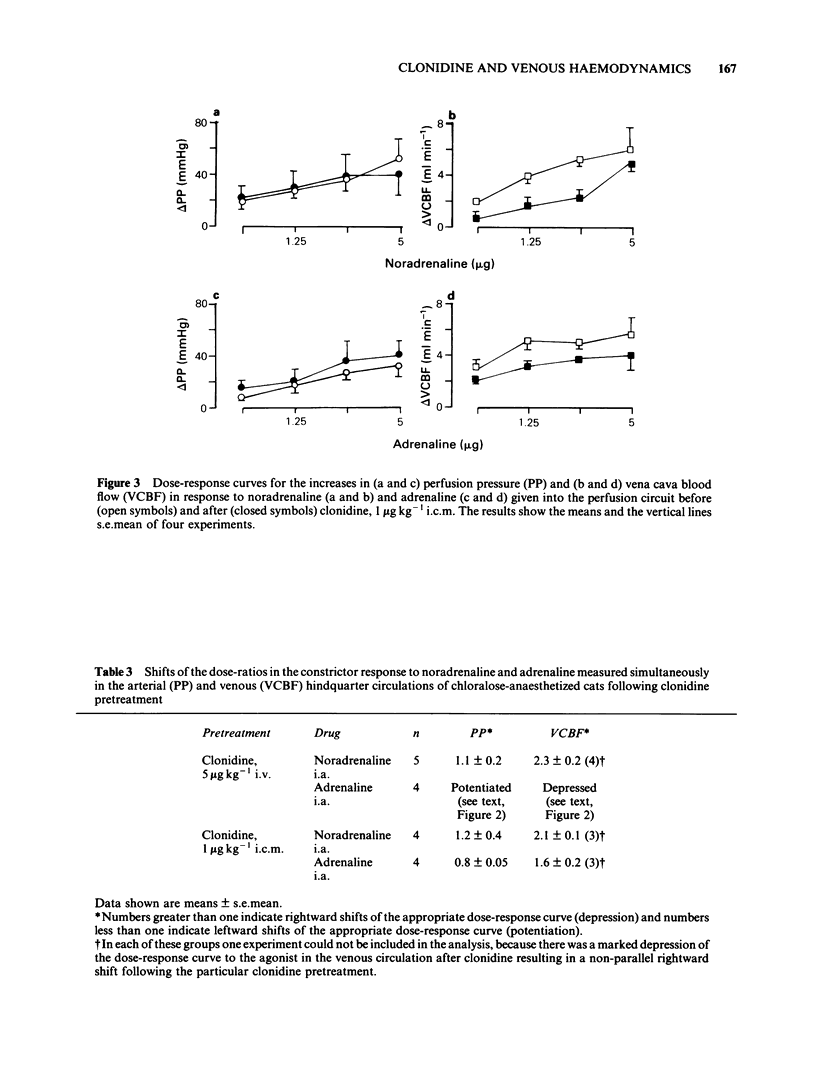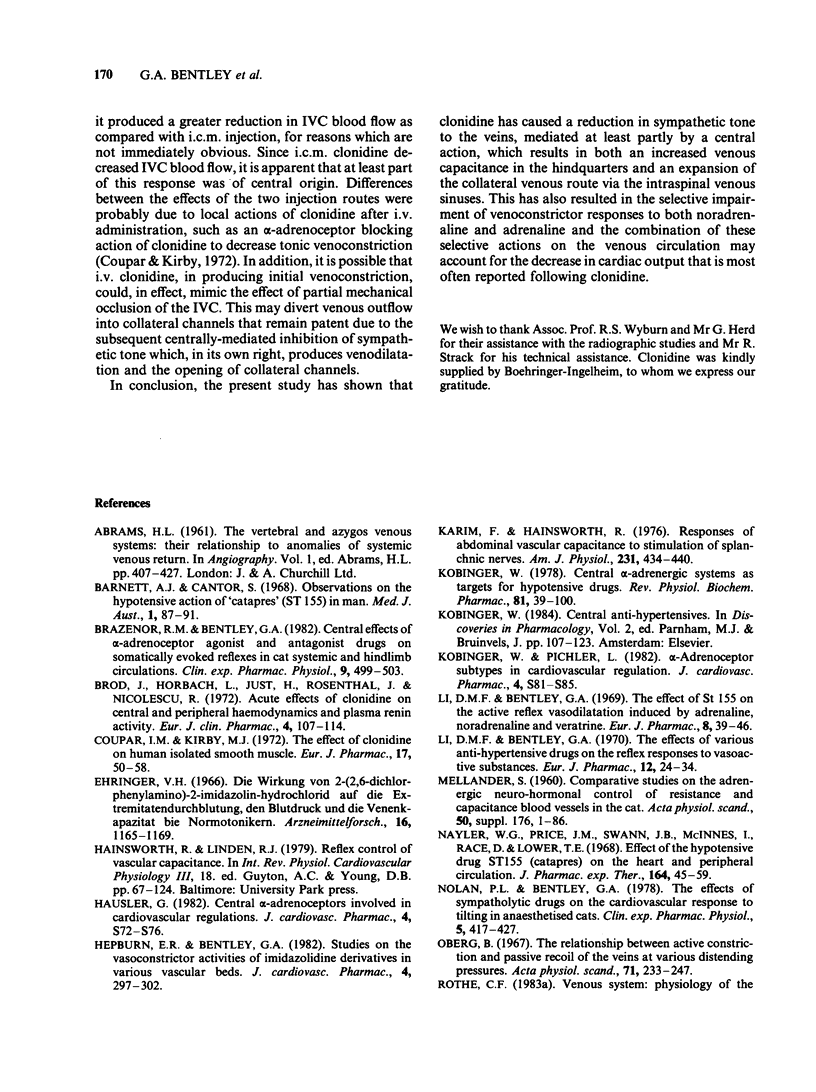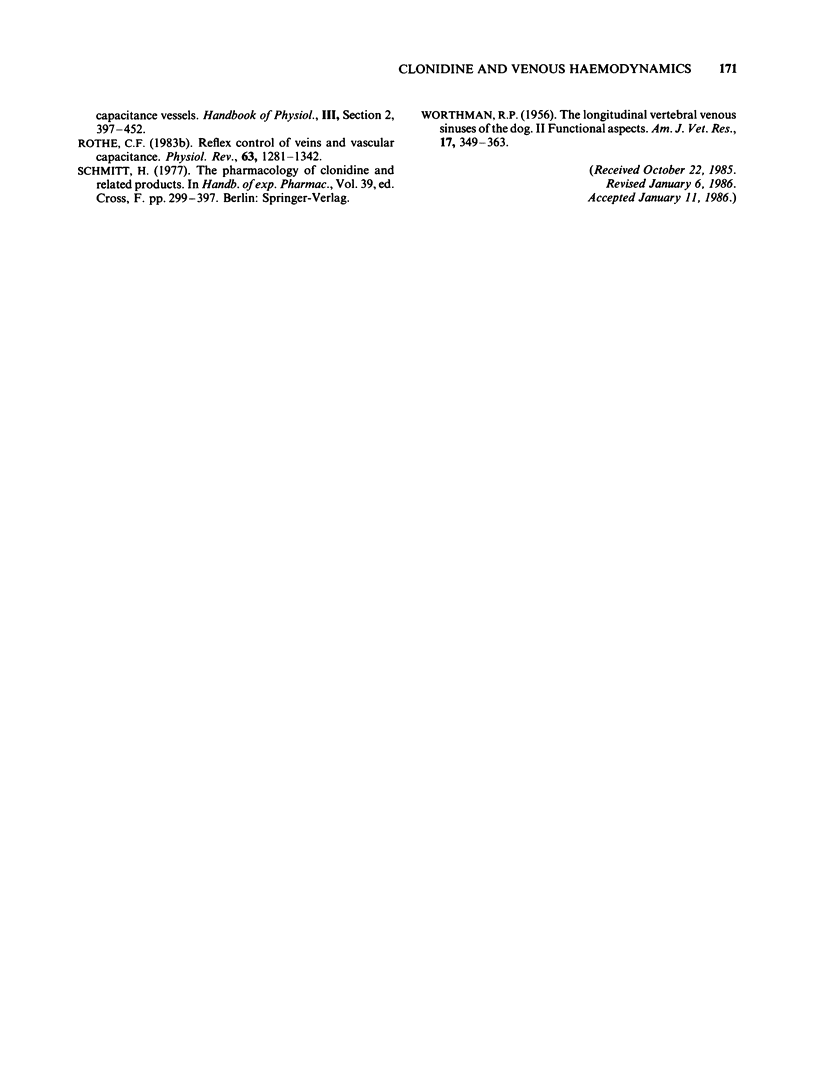Abstract
Experiments were undertaken to investigate a possible action of clonidine on venous haemodynamics, using cats and dogs with autoperfused hindquarters. This provided an arterial input to the region independent of cardiac output. Venous capacitance in the hindquarters was indicated by blood flow in the abdominal vena cava, as measured by an electromagnetic flow probe around this vessel. It was found that in both cats and dogs, clonidine given intravenously (5 micrograms kg-1 i.v.) or into the cisterna magna (1 microgram kg-1 i.c.m.) reduced mean arterial pressure and heart rate, but did not decrease hindquarter perfusion pressure. With the exception of dogs given i.v. clonidine, this drug caused a decrease in inferior vena cava (IVC) blood flow and this closely paralleled the hypotensive effect. However, when clonidine was given i.v. to dogs, the decrease in IVC blood flow preceded the hypotension. At the doses used, the reduction in IVC blood flow was larger following i.v. than i.c.m. clonidine in both species, and in all cases, it remained below control levels for at least 30 min, in spite of the constant arterial input to the region. In cats, dose-response curves were constructed to noradrenaline and adrenaline given into the perfusion circuit (i.a.) before and after clonidine. Following i.v. and i.c.m. clonidine, there was a selective depression of the venoconstrictor actions of the catecholamines, but no change in the arterial pressor action. Radiographic and latex studies in the dog and cat respectively were performed in order to visualize collateral blood flow that could account for the persistent decreases in IVC blood flow. In both species, intraspinal collateral flows were demonstrated which returned blood to the heart after ligation of the inferior vena cava below the renal veins. However, it was not possible to demonstrate radiographically any changes produced by clonidine in the collateral flow because of technical difficulties. These results suggest that clonidine causes a selective reduction in sympathetic tone to the veins that is mediated at least partly by a central action, as well as an expansion of the collateral venous routes. This, together with the selective impairment of venoconstrictor responses to both noradrenaline and adrenaline, may account for the decrease in cardiac output that is most often reported following clonidine.
Full text
PDF










Selected References
These references are in PubMed. This may not be the complete list of references from this article.
- Barnett A. J., Cantor S. Observations on the hypotensive action of "Catapres" (ST 155) in man. Med J Aust. 1968 Jan 20;1(3):87–91. doi: 10.5694/j.1326-5377.1968.tb27492.x. [DOI] [PubMed] [Google Scholar]
- Brazenor R. M., Bentley G. A. Central effects of alpha-adrenoceptor agonist and antagonist drugs on somatically evoked reflexes in cat systemic and hindlimb circulations. Clin Exp Pharmacol Physiol. 1982 Sep-Oct;9(5):499–503. doi: 10.1111/j.1440-1681.1982.tb00824.x. [DOI] [PubMed] [Google Scholar]
- Brod J., Horbach L., Just H., Rosenthal J., Nicolescu R. Acute effects of clonidine on central and peripheral haemodynamics and plasma renin activity. Eur J Clin Pharmacol. 1972 Mar;4(2):107–114. doi: 10.1007/BF00562506. [DOI] [PubMed] [Google Scholar]
- Coupar I. M., Kirby M. J. The effect of clonidine on human isolated smooth muscle. Eur J Pharmacol. 1972 Jan;17(1):50–58. doi: 10.1016/0014-2999(72)90268-3. [DOI] [PubMed] [Google Scholar]
- Ehringer H. Die Wirkung von 2-(2,6-Dichlorphenylamino)-2-imidazolin-hydrochlorid auf die Extremitätendurchblutung, den Blutdruck und die Venenkapazität bei Normotonikern. Arzneimittelforschung. 1966 Sep;16(9):1165–1169. [PubMed] [Google Scholar]
- Hainsworth R., Linden R. J. Reflex control of vascular capacitance. Int Rev Physiol. 1979;18:67–124. [PubMed] [Google Scholar]
- Hepburn E. R., Bentley G. A. Studies on the vasoconstrictor activities of imidazolidine derivatives in various vascular beds. J Cardiovasc Pharmacol. 1982 Mar-Apr;4(2):297–302. doi: 10.1097/00005344-198203000-00019. [DOI] [PubMed] [Google Scholar]
- Häusler G. Central alpha-adrenoceptors involved in cardiovascular regulation. J Cardiovasc Pharmacol. 1982;4 (Suppl 1):S72–S76. [PubMed] [Google Scholar]
- Karim F., Hainsworth R. Responses of abdominal vascular capacitance to stimulation of splachnic nerves. Am J Physiol. 1976 Aug;231(2):434–440. doi: 10.1152/ajplegacy.1976.231.2.434. [DOI] [PubMed] [Google Scholar]
- Kobinger Central alpha-adrenergic systems as targets for hypotensive drugs. Rev Physiol Biochem Pharmacol. 1978;81:39–100. doi: 10.1007/BFb0034091. [DOI] [PubMed] [Google Scholar]
- Kobinger W., Pichler L. alpha-Adrenoceptor subtypes in cardiovascular regulation. J Cardiovasc Pharmacol. 1982;4 (Suppl 1):S81–S85. doi: 10.1097/00005344-198200041-00017. [DOI] [PubMed] [Google Scholar]
- Li D. M., Bentley G. A. The effect of St 155 on the active reflex vasodilatation induced by adrenaline, noradrenaline and veratrine. Eur J Pharmacol. 1969 Oct;8(1):39–46. doi: 10.1016/0014-2999(69)90127-7. [DOI] [PubMed] [Google Scholar]
- Li D. M., Bentley G. A. The effects of various anti-hypertensive drugs on the reflex responses to vasoactive substances. Eur J Pharmacol. 1970 Sep 1;12(1):24–34. doi: 10.1016/0014-2999(70)90025-7. [DOI] [PubMed] [Google Scholar]
- MELLANDER S. Comparative studies on the adrenergic neuro-hormonal control of resistance and capacitance blood vessels in the cat. Acta Physiol Scand Suppl. 1960;50(176):1–86. [PubMed] [Google Scholar]
- Nayler W. G., Price J. M., Swann J. B., McInnes I., Race D., Lowe T. E. Effect of the hypotensive drug ST 155 (Catapres) on the heart and peripheral circulation. J Pharmacol Exp Ther. 1968 Nov;164(1):45–59. [PubMed] [Google Scholar]
- Nolan P. L., Bentley G. A. The effects of sympatholytic drugs on the cardiovascular response to tilting in anaesthetized cats. Clin Exp Pharmacol Physiol. 1978 Sep-Oct;5(5):417–427. doi: 10.1111/j.1440-1681.1978.tb00693.x. [DOI] [PubMed] [Google Scholar]
- Oberg B. The relationship between active constriction and passive recoil of the veins at various distending pressures. Acta Physiol Scand. 1967 Oct-Nov;71(2):233–247. doi: 10.1111/j.1748-1716.1967.tb03729.x. [DOI] [PubMed] [Google Scholar]
- Rothe C. F. Reflex control of veins and vascular capacitance. Physiol Rev. 1983 Oct;63(4):1281–1342. doi: 10.1152/physrev.1983.63.4.1281. [DOI] [PubMed] [Google Scholar]
- WORTHMAN R. P. The longitudinal vertebral venous sinuses of the dog. II. Functional aspects. Am J Vet Res. 1956 Jul;17(64):349–363. [PubMed] [Google Scholar]


